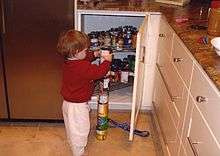Pervasive refusal syndrome
Pervasive refusal syndrome (PRS), now referred to as pervasive arousal withdrawal syndrome (PAWS), is a rare but serious child psychiatric disorder that was first described by Bryan Lask and colleagues in 1991.[1] As of 2011, it is not included in the standard psychiatric classification systems.[2] PRS is the name allotted to a disorder in which children have abandoned their involvement in all phases of their life. It's characterized by refusal to eat, drink, talk, walk or self-care, and a firm resistance to treatment.[3] PRS is very rare and its cause is unclear, but its severity makes it life-threatening. The disorder usually begins with a 'virus', or the child having a 'pain', that results in the need for consulting a doctor or going to the hospital, even though no substantial cause can be found. PRS starts slowly, but the child then worsens quickly becoming reluctant or not capable to do anything for themselves.[3] They originally refuse to accept others caring for them, or helping them eat, and are very depressed and distraught. It is not guaranteed that recovery will take place, and it is a lengthy and complex process, involving specialist medical care.[3] Nevertheless, once the patient is healthy, relapse is very infrequent.
A family with a psychiatric history or environmental stress factors can also play a role. Hospitalization is almost always necessary and the recovery period is lengthy; typically 12.8 months. During the recovery period symptoms disappear in the opposite order they appear.[4] About 67% of the cases show complete recovery.[5]
PRS may be linked to learned helplessness, and so it can be important for the patient to be able to manage the rate of their recovery. Music therapy may help in this regard as it provides empowerment by giving the patient choice and control, while allowing for improvisation can result in a sense of affirmation and validation; all important for a successful recovery.[6]

Epidemiology
Pervasive refusal syndrome is for the most part frequently seen in girls and less so in boys. The average age of onset is between the ages of 7 and 15.[7] Affected children are usually high achievers with high self-expectations, fears of failure, and difficulty dealing with failure to achieve personal standards.[8] The onset of PRS is usually acute.[8]
Symptoms

PRS symptoms have common characteristics with many other psychiatric disorders. However, none of the present DSM diagnoses can account for the full scope of symptoms seen in PRS, and refusal to eat, weight loss, social withdrawal and school refusal can be considered as the main distinctive features.[7] Any system may be involved, however some more commonly engaged than others.[9]
- recurring pain
- nausea
- loss of appetite
- headache
- seizure
- motor dysfunction
- sensory dysfunction
- fatigue
- altered consciousness
- joint pains
- muscle weakness
Etiology
Trauma, in general, appears to be a vital etiological aspect, due to the fact that PRS is also repeatedly seen in refugees and witnesses to violence.[7] The helplessness and hopelessness can transmit from parents to children and from children to parents as they watch one another battling with uncontrollable proceedings.[7] Viral infections are repeatedly seen to be a factor in PRS; many cases are thought to begin with a viral infection. There have been other theories regarding the etiology of PRS, for instance, the psychodynamic theory of fatal mothering and a potential neurobiological role of the insula.[7] Von Folsach and Montgomery put forth four essential etiologic factors: (1) a premorbid personality, (2) a history of child psychiatric problems, (3) parental psychiatric problems and (4) sudden stressful events.[7] PRS children are typically known to be perfectionists, conscientious and high achievers. When these children are put in stressful events that they feel they cannot control, they go into a state of learned helplessness. Previous child psychiatric problems can designate a susceptibility to develop PRS when put in stressful situations, and parental psychiatric problems may influence the parents' capability to support and care for their children.[7]
Diagnosis
Thompson and Nunn were the first to introduce diagnostic criteria for PRS in 1997. The current diagnostic criteria consists of:[7]
- A) Partial or complete refusal in three or more of the following areas: (1) eating, (2) moving, (3) speech, (4) interest to personal care
- B) Active and angry resistance to acts of help and support
- C) Social withdrawal and school refusal
- D) No organic condition accounts for the severity of the degree of symptoms
- E) No other psychiatric disorder could better account for the symptoms
- F) The endangered state of the patient requires hospitalization[7]
Learned helplessness model
Seligman's (1990) model of learned helplessness embodies that the learned expectation of having no control over matters in the environment is met with a generalized passivity response.[10] It is speculated that the interactions between the child and events in their surroundings can end in the child encountering feelings of helplessness and therefore, a loss of personal hopefulness.[10] The patient is scared to take part in the world and feels inadequate in facing internal and external experiences, which he or she experiences through the world and thinking about his or her emotional encounters.[10] This model is effective in explaining the degradation in children with PRS when trying to rehabilitate them. If the child or adolescent is experiencing the treatment intervention as forceful, then their feeling of helplessness increases.[10]
Comorbidity
Autism and PRS

Autism is a neural development disorder defined by flawed social interaction and communication, and by restricted and repetitive behavior.[11] The patient with autism displays substantial deficit in all three core deficits of PRS which include: impairments in social interaction, impairments in communication, and restricted and stereotyped patterns of behavior, interests, and activities.[11]
Asperger's syndrome and PRS
Asperger's syndrome (AS) is characterized by considerable problems in social interaction, other notable symptoms include restricted and repetitive patterns of behavior and activities.[11] Patient with AS generally has no setback in language cognitive maturity, or self-help abilities but has clear language skill deficits, problems in social interaction, and odd behavior in interests and activities characteristic of PRS.[11] The lack of cognitive development deficits enables the patient with AS to perform at a more advanced level than people who have other forms of PRS.[11]
Treatment
Unfortunately, no evidence-based treatment is known for PRS. However it is widely accepted that the treatment must incorporate a complete multidisciplinary team approach and a controlled yet flexible management plan with a visible basis engaged over months to years.[7] Recovery from pervasive refusal syndrome is slow, usually demands one year after diagnosis and introduction of treatment, but many children have a complete recovery and relapse is almost never seen. It is important to remember that adding pressure on recovery times can set him or her back.[8]
Inpatient treatment
Due to the fact that PRS is such a severe disorder, it is almost always required to hospitalize in a child and adolescent psychiatric unit.[7] Outpatient treatment does display symptom-free periods, but relapses of short-lived episodes of depressive symptoms or anorexia are observed.[7] It is therefore necessary to partake in inpatient treatment. Treatment ought to involve gentle loving care. The person treating the patient must be very sensitive and tolerant because it takes a long period of time for the patient to get better, and putting pressure on them adds severity to their condition.[7] It frequently takes several months of treatment before it is likely to employ a very steady rehabilitation programme.[7]
Role of the family
The role of the family in the treatment process is vital yet complicated, given that withdrawal of the child from therapy is a key problem. It is important to include the family of the patient in the treatment process as it eases family anxiety and distress.[7] Nonetheless, it is important to create some space because too much involvement of the family may be counterproductive. Medication seems to play a very restricted part in the management of pervasive refusal syndrome (PRS), having importance in the treatment of comorbid disorders only, for example antidepressants for comorbid depression.[7]
References
- ↑ Lask B, Britten C, Kroll L, Magagna J, Tranter M (1991). "Children with pervasive refusal". Archives of Disease in Childhood. 66: 866–869. doi:10.1136/adc.66.7.866.
- ↑ Grahame, V.; Reid, C.; Rao, S.; Guirguis, S.; Kaplan, C. (2011). "P01-290 - Pervasive refusal syndrome: comparing and contrasting clinical cases". European Psychiatry. 26: 291. doi:10.1016/S0924-9338(11)72001-6. ISSN 0924-9338.
- 1 2 3 "Pervasive Refusal Syndrome: A Parent's Perspective". Clinical Child Psychology and Psychiatry. 6 (3): 455–469. July 2001. doi:10.1177/1359104501006003012.
- ↑ Lask B (2004). "Pervasive Refusal Syndrome among Asylum-seeking Children". Advances in Psychiatric Treatment. The Royal College of Psychiatrists. 10 (2): 153–159. doi:10.1192/apt.10.2.153. Retrieved 2011-06-10.
- ↑ Jaspers T, Hanssen GM, van der Valk JA, Hanekom JH, van Well GT, Schieveld JN (November 2009). "Pervasive refusal syndrome as part of the refusal-withdrawal-regression spectrum: critical review of the literature illustrated by a case report". European Child & Adolescent Psychiatry. 18 (11): 645–651. doi:10.1007/s00787-009-0027-6. PMC 2762526
 . PMID 19458987.
. PMID 19458987. - ↑ van der Walt M, Annette B (2006). "The Role of Music Therapy in the Treatment of a Girl with Pervasive Refusal Syndrome: Exploring Approaches to Empowerment". Australian Journal of Music Therapy. 17: 35–53. Retrieved 2011-06-11.
- 1 2 3 4 5 6 7 8 9 10 11 12 13 14 15 16 Jaspers T, Hanssen GM, van der Valk JA, Hanekom JH, van Well GT, Schieveld JN (2009). "Pervasive refusal syndrome as part of the refusal–withdrawal–regression spectrum: critical review of the literature illustrated by a case report". European Child & Adolescent Psychiatry. 18 (18): 645–651. doi:10.1007/s00787-009-0027-6. PMC 2762526
 . PMID 19458987.
. PMID 19458987. - 1 2 3 Sharlin, Judith; Edelstein, Sari (2010). Essentials of Life Cycle Nutrition. Canada: Jones and Bartlett Learning. p. 188. ISBN 9780763777920.
- 1 2 3 4 Coghill, David; Sally Bonnar; Sandra Duke; Sarah Seth; Johnny Graham (2009). Child and Adolescent Psychiatry. Oxford University Press. p. 310. ISBN 9780199234998.
- 1 2 3 4 Magagna, J. (2012). The Silent Child: Communication Without Words. London: Karnac Books. p. 141. ISBN 9781855755185.
- 1 2 3 4 5 Searcy, Eileen (2001). "Helping the patient who has pervasive development disorder". Journal of the American Academy of Physician Assistants. 14 (10): 39.